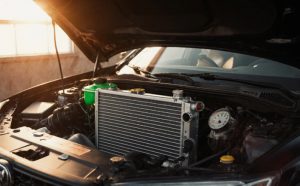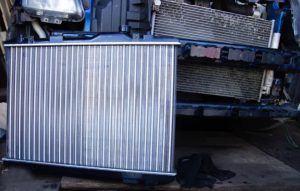Radiators are essential to maintaining an engine’s optimal operating temperature — but like all metal components exposed to heat, moisture, and chemicals, they face constant wear. Over time, corrosion, oxidation, and environmental contaminants can degrade the radiator’s internal and external surfaces, leading to leaks, overheating, and costly replacements.
Fortunately, modern engineering offers a range of advanced coatings and surface treatments that can significantly extend the radiator’s lifespan. These technologies are designed to enhance corrosion resistance, heat transfer efficiency, and structural durability — ensuring the cooling system performs reliably under even the harshest conditions.
Why Radiator Longevity Depends on Surface Protection

Traditional radiators were often made of copper or brass, which provided good thermal conductivity but limited corrosion resistance. Today’s models, primarily made from aluminum alloys, offer lighter weight and higher efficiency — but they’re also more vulnerable to corrosion if not properly protected.
Common Factors That Shorten Radiator Life:
-
Electrolytic corrosion: Caused by electrical currents in coolant due to poor grounding.
-
Oxidation: Reaction between metal and oxygen, forming weak rust spots.
-
Chemical corrosion: Result of improper coolant or incompatible additives.
-
Environmental wear: Dirt, salt, and debris that accumulate on external fins.
Without protective coatings or treatments, these elements gradually weaken radiator materials and compromise cooling performance.
| Damage Type | Primary Cause | Effect on Radiator |
|---|---|---|
| Oxidation | Exposure to air and moisture | Weakens metal surfaces |
| Chemical attack | Acidic or contaminated coolant | Erodes inner tubes |
| Galvanic corrosion | Contact between dissimilar metals | Creates pinholes and leaks |
| Thermal stress | Repeated heating and cooling | Leads to cracks or warping |
Types of Advanced Radiator Coatings
Modern coatings are designed not only to prevent rust but also to improve heat dissipation and reduce friction within coolant channels. Below are some of the most effective types used in contemporary radiator manufacturing and refurbishment.
A. Epoxy-Based Coatings
Epoxy coatings form a durable, corrosion-resistant barrier on both internal and external surfaces. They are highly adhesive and resistant to chemicals and temperature fluctuations.
Advantages:
-
Excellent corrosion and chemical resistance.
-
Smooth finish minimizes internal buildup.
-
Suitable for aluminum and copper radiators.
Application Areas:
Typically used inside tubes and around joints to prevent coolant-side corrosion.
B. Ceramic Coatings
Ceramic-based coatings are used in high-performance or heavy-duty radiators, especially in motorsport and off-road applications. These coatings can withstand extreme temperatures and reduce surface oxidation.
Key Benefits:
-
High heat tolerance (up to 1000°C).
-
Enhanced heat dissipation efficiency.
-
Prevents external rust caused by road salt and debris.
| Ceramic Coating Property | Performance Benefit |
|---|---|
| High thermal conductivity | Better heat transfer |
| Non-reactive surface | Prevents corrosion |
| UV stability | Resists weathering |
C. Anodizing (for Aluminum Radiators)
Anodizing is an electrochemical process that thickens the natural oxide layer on aluminum, making it harder and more corrosion-resistant.
Advantages:
-
Lightweight protection without adding bulk.
-
Increases surface hardness.
-
Improves compatibility with various coolants.
Types of Anodizing Used in Radiators:
-
Clear anodizing: Transparent protection for stock applications.
-
Hard anodizing: Darker, more durable coating for performance or industrial use.
D. Powder Coating
Powder coating provides an even, protective finish that shields against environmental factors like humidity, dust, and salt.
Why It’s Popular:
-
Resistant to chipping, fading, and abrasion.
-
Aesthetic appeal with customizable finishes.
-
Strong barrier against external corrosion.
Note: The coating must be applied thinly to avoid reducing heat transfer efficiency.
Internal Treatments: Protecting the Radiator from the Inside
While coatings protect the outer surface, internal treatments ensure long-term coolant compatibility and corrosion control.
A. Phosphate Coating
A common pre-treatment that helps reduce chemical reactions between coolant and metal. It also improves paint or coating adhesion.
B. Nanoceramic Treatments
Nanotechnology-based coatings create ultra-thin layers that smooth out microscopic imperfections inside radiator tubes, reducing friction and preventing buildup.
Benefits:
-
Prevents scaling and sedimentation.
-
Improves coolant flow and heat exchange.
-
Extends service life by minimizing chemical corrosion.
C. Anti-Corrosion Additives
These additives can be mixed directly with coolant to maintain protective layers on internal surfaces.
| Additive Type | Function | Usage Frequency |
|---|---|---|
| Silicate-based | Creates barrier film | Every coolant change |
| Organic Acid Technology (OAT) | Long-life corrosion inhibitor | Every 5 years |
| Hybrid OAT (HOAT) | Combines silicate + organic acids | Every 3–4 years |
Maintenance Practices to Preserve Coating Effectiveness
Even the most advanced coatings require proper care to stay effective. Neglect can undermine their benefits and lead to premature wear.
Essential Maintenance Tips:
-
Flush the cooling system regularly (every 2–3 years). Old coolant can degrade protective layers.
-
Avoid mixing coolant types. Chemical incompatibilities can strip protective films.
-
Inspect radiator fins for dirt and salt deposits — clean gently with compressed air or a soft brush.
-
Check grounding and electrical connections to prevent electrolysis corrosion.
-
Store vehicles properly during long idle periods to prevent moisture buildup.
| Maintenance Action | Interval | Purpose |
|---|---|---|
| Coolant flush | 24–36 months | Prevent internal corrosion |
| External cleaning | Every 6 months | Remove dirt and salt |
| Leak inspection | Every oil change | Detect early corrosion damage |
| Coolant test (pH & inhibitor level) | Yearly | Maintain chemical balance |
Choosing the Right Coated Radiator
When replacing or upgrading your radiator, always verify what type of protective coating or treatment it includes. High-quality aftermarket or OEM radiators often feature anodized aluminum cores, epoxy-coated tanks, and anti-corrosive finishes designed to withstand long-term use.
Consider the following factors:
-
Driving conditions: Off-road or coastal environments demand stronger coatings.
-
Material type: Aluminum radiators benefit most from anodizing; copper ones from epoxy coatings.
-
Coolant compatibility: Use only manufacturer-approved coolants to maintain coating integrity.
For durable and corrosion-resistant options, you can Buy Radiator & Components online — including radiators, caps, hoses, and mounting hardware built with advanced protective technologies.
Future Trends in Radiator Coating Technology

Innovation in materials science continues to improve radiator durability. The next generation of coatings aims to combine self-healing polymers, graphene-enhanced ceramics, and smart nanocoatings that can automatically repair microscopic cracks or resist chemical breakdown.
Emerging Developments:
-
Graphene-infused coatings: Ultra-thin yet highly conductive and corrosion-proof.
-
Self-healing polymers: React to minor damage by restoring protective layers.
-
Hybrid nano-ceramics: Combine ceramic hardness with flexibility for better thermal expansion resistance.
These advancements promise longer-lasting, maintenance-free radiators suited for both traditional combustion engines and high-efficiency EV cooling systems.
Conclusion
Protecting your radiator with advanced coatings and treatments isn’t just about extending its life — it’s about safeguarding the entire cooling system and preventing costly engine damage. From epoxy and ceramic coatings to anodized finishes and nanoceramic treatments, each technology offers unique benefits that enhance durability and efficiency.
With regular maintenance and the right surface protection, your radiator can perform flawlessly for years. When it’s time to replace or upgrade, choose high-quality, corrosion-resistant parts — and always Buy Radiator & Components online to ensure long-term reliability and top-tier performance.